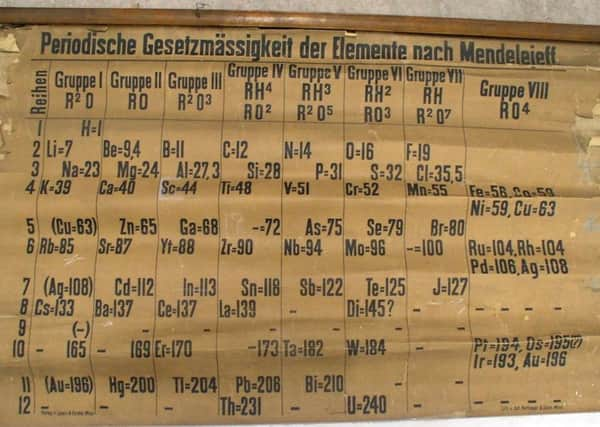St Andrews periodic table confirmed as world’s oldest


The chart of elements, dating from 1885, was discovered in the University’s School of Chemistry in 2014 during a clear out of a walk-in cupboard.
Now, following international news coverage of the find, the periodic table chart has been formally certified as the world’s oldest by the Guinness World Records.
Advertisement
Hide AdAdvertisement
Hide AdThe storage areas where it was found was full of chemicals, equipment and laboratory paraphernalia that had accumulated since the opening of the chemistry department at its existing location in 1968.
Following months of clearing and sorting the various materials, a hoard of rolled up teaching charts was discovered. Within the collection was a large, extremely fragile periodic table that flaked upon handling.
Suggestions the discovery may be the earliest surviving example of a classroom periodic table in the world meant the document required urgent attention to be authenticated, repaired and restored.
Russian chemist and inventor Dmitri Ivanovich Mendeleev made his famous disclosure on periodicity in 1869. The newly unearthed table, instantly recognisable as clearly an early specimen, was similar, though not identical to Mendeleev’s second table of 1871. Following the discovery in 2014, the periodic table chart was subsequently sent for authentication and to be preserved for future generations. Marking the International Year of the Periodic Table, the fully restored chart was unveiled at a special event at the European Parliament to celebrate 150 years of the Periodic Table in January.
The table is annotated in German. An inscription at the bottom left – Verlag v. Lenoir & Forster, Wien – identifies a scientific printer who operated in Vienna between 1875 and 1888.
Another inscription – Lith. von Ant. Hartinger & Sohn, Wien – identifies the chart’s lithographer, who died in 1890.
Working with the university’s special collections team, the St Andrews institution sought advice from a series of international experts. Investigations found no earlier lecture chart of the table appears to exist.
Professor Eric Scerri, an expert on the history of the periodic table, based at the University of California, dated the table to between 1879 and 1886 based on the represented elements.
Both gallium and scandium, discovered in 1875 and 1879 respectively, are present, but germanium, which was discovered in 1886, is not.